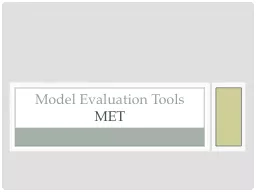

MET What is MET Model Evaluation Tools MET a powerful and highly configurable verification package developed by DTC offering Standard verification scores comparing gridded model data to pointbased observations ID: 341368
Download Presentation The PPT/PDF document "Model Evaluation Tools" is the property of its rightful owner. Permission is granted to download and print the materials on this web site for personal, non-commercial use only, and to display it on your personal computer provided you do not modify the materials and that you retain all copyright notices contained in the materials. By downloading content from our website, you accept the terms of this agreement.
Slide1
Model Evaluation Tools
METSlide2
What is MET
Model Evaluation Tools
(
MET
)-
a powerful and highly configurable verification package developed by DTC offering:
Standard verification scores comparing gridded model data to point-based observations
Standard verification scores comparing gridded model data to gridded observations
Spatial verification methods comparing gridded model data to gridded observations using neighborhood, object-based, and intensity-scale decomposition approaches
Ensemble and probabilistic verification methods comparing gridded model data to point-based or gridded observations
Aggregating the output of these verification methods through time and
spaceSlide3
What is METSlide4
MET Steps
Configuration:
A configuration file* (specific to each MET tool) detailing the different verification settings needs to be configured and supplied prior to a MET verification run.
-ASCII text format
-All settings are explained in comments in the file -Can be reused for multiple runs*More info on all of the settings in the configuration file can be found in the MET Tutorial PDF, available at http://www.dtcenter.org/met/users/docs/overview.phpSlide5
MET Steps
Running selected MET Tool:
-MET Tool name
-Forecast data file
-Observation data file -Configuration file -Output directory -Additional argumentsExample for GRID-STAT:METv3.0.1/bin/grid_stat "$FCST_FILE" "$OBS_FILE" “$CONFIG_FILE” –
outdir
"
$
OUTPUT_DIRECTORY"
-v 2
;
Example for POINT-STAT:
METv3.0.1/bin
/
point_stat
“$FCST_FILE” “$OBS_FILE” “$CONFIG_FILE” –
outdir
“$OUTPUT_DIRECTORY” –v 2;Slide6
MET automation
Without automation, MET verifies 1 forecast file with 1 observation file
and is nearly impossible to use for actual data sets. Usually only used for
testing
Shell Scripts provide:
-Speed (MET tools are run thousands of times over entire data sets)-Control (MET is run using specified settings or only if conditions are met)-Data collection, formatting and conversion-Ideal bookkeeping (Based on time, settings, etc.)-
Custom, correct, and consistent output
filenames
-
Tree-like folder structure ideal for
METViewer
-
Easily adjusted to run over different models and/or timesSlide7
MET Automation
Depending on usage, automation scripts can vary greatly. However, most tend to have a general structure:
1. Set settings (period, domain, initialization times,
etc.)
2. Gather forecast data
3
. Gather observation data 4. Reformat forecast and observation data to be MET-readable 5. Iterate over time, computing forecast and observation filenames 6. If a match is found in step 5, run MET tool with given parameters from step 1 7. Aggregate and reformat output data 8. Repeat for different modelsSlide8
DTC/HMT Collaboration: Ensemble QPF Comparisons
Area under
the ROC Curve for SREF and WRF ensembles for 3 IOPs in February 2011 over California Domain for Rainfall
g
reater than 0.5 inchSlide9
MODE Attributes and Model Diagnostics
Ensemble Members and Systematic Microphysics Impacts
Thompson microphysics scheme members: Colors 5-7
Others are Ferrier or Schultz
Thompson members are less Intense but larger (see averages especially)
Note
extrema
tails for both size and intensity (medians vs. averages) Slide10
Graphics
MET does not have a built in way to display the computed
statistics
MET outputs all statistics in ASCII text files which can be be plotted by many different software packages if desired, or
METViewer
can be
used
MET Viewer is a separate software package which visualizes MET output and is highly configurableSlide11
More
i
nformation
MET &
MET
Viewer
on FAB Website:http://laps.noaa.gov/met/DTC Online MET Tutorial: http://www.dtcenter.org/met/users/support/online_tutorial/METv3.0/index.phpSlide12
MET
ViewerSlide13
What is MET
Viewer
The
MET
Viewer
tool reads MET verification statistics output from a databasecreates plots using the R statistical packageincludes a web application that can be accessed from a web browser to create a single plotthe specification for each plot is built using a series of controls and then serialized into XMLfor each plot, METViewer generates a SQL query, an R script to create the plot, a flat file containing the data that will be plotted and the plot itself
Available
to anyone online:
http
://www.dtcenter.org/met/metviewer/metviewer.jsp?db=hmt_2010
Note
:
the link is
a public test version and hence is limited to a single database.Slide14
METViewer
Fully customizable and very powerful but has a learning
curve
Can produce fully customizable:
-Series
plots with confidence
intervals -Box plots -X-Y scatter plots -HistogramsSlide15
METViewer Usage
METViewer is designed to be configured in a downward direction. This means that the user should set the desired settings in order, gradually moving downward.
The top three settings (shown above) allow the user to select a database and type for the plot.Slide16
METViewer
Usage
T
he Y2 axis can be used to plot a Base Rate.Slide17
ResultSlide18
What MET
Viewer Offers
Useful options that are in
MET
Viewer
Standard scores: RMSE,ME,MAE,GSS,CSI,FAR,....Ensemble utilities: ensemble mean, spread, probabilities, ROC, Brier….Formats: Time series, bar plots, boxplots, rank histograms,….Aggregate on-the fly, over thresholds, forecast times, valid times, lead times, etc.Uncertainty options: boxplot notches, error bars, sub-sampling,…Spatial Techniques displays: MODE, Wavelet methods, neighborhood methodsSlide19
Result
Aggregated by diurnal cycle valid times; Comparison of one gridded dataset with another gridded dataset (
StageIV
and ‘improved’
StageIV
)Slide20
Result
30-day aggregations, with multiple models and ensemble members, plotted over lead times